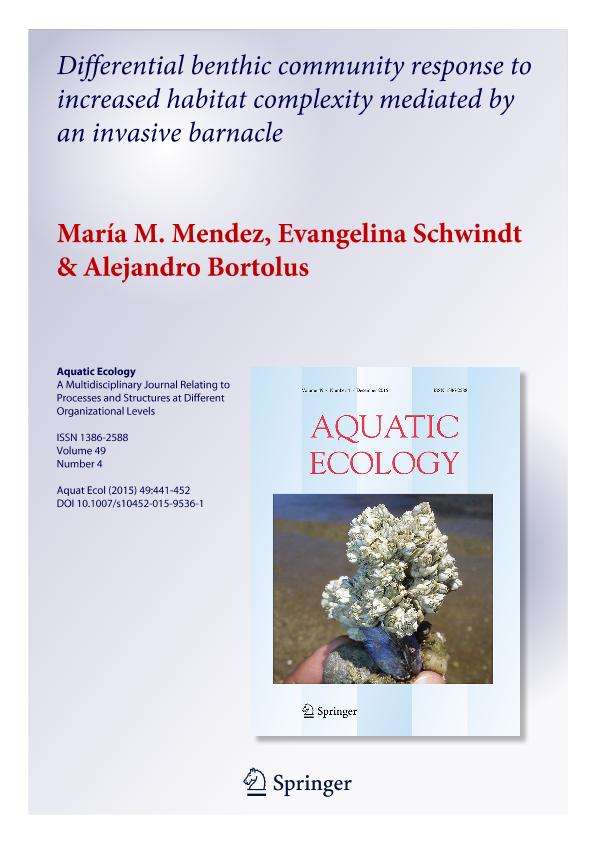Mostrar el registro sencillo del ítem
dc.contributor.author
Mendez, María Martha

dc.contributor.author
Schwindt, Evangelina

dc.contributor.author
Bortolus, Alejandro

dc.date.available
2018-02-27T19:16:03Z
dc.date.issued
2015-12
dc.identifier.citation
Mendez, María Martha; Schwindt, Evangelina; Bortolus, Alejandro; Differential benthic community response to increased habitat complexity mediated by an invasive barnacle; Springer; Aquatic Ecology; 49; 4; 12-2015; 441-452
dc.identifier.issn
1386-2588
dc.identifier.uri
http://hdl.handle.net/11336/37307
dc.description.abstract
Invasive species threaten native ecosystems worldwide. However, these species can interact positively with local communities, increasing their richness, or the abundance of some species. Many invasive species are capable of influencing the habitat itself, by ameliorating physical stress and facilitating the colonization and survival of other organisms. Barnacles are common engineer species that can change the physical structure of the environment, its complexity, and heterogeneity through their own structure. Balanus glandula is a native barnacle of the rocky shores of the west coast of North America. In Argentina, this invasive species not only colonizes rocky shores but it also has successfully colonized soft-bottom salt marshes, where hard substrata are a limiting resource. In these environments, barnacles form three-dimensional structures that increase the structural complexity of the invaded salt marshes. In this work, we compared the composition, density, richness, and diversity of the macroinvertebrate assemblages associated with habitats of different structural complexity in two Patagonian salt marshes where B. glandula is well established. Our results showed differences in the relative distribution and abundances of the invertebrate species between habitats of different complexities. Furthermore, the response of the communities to the changes in the structural complexity generated by B. glandula was different in the two marshes studied. This highlights the fact that B. glandula facilitates other invertebrates and affect community structure, mainly where the settlement substrata (Spartina vs. mussels) are not functionally similar to the barnacle. Thus, our work shows that the rocky shore B. glandula is currently a critical structuring component of the native invertebrate community of soft-bottom environments where this species was introduced along the coast of southern South America.
dc.format
application/pdf
dc.language.iso
eng
dc.publisher
Springer

dc.rights
info:eu-repo/semantics/openAccess
dc.rights.uri
https://creativecommons.org/licenses/by-nc-sa/2.5/ar/
dc.subject
Balanus Glandula
dc.subject
Exotic Species
dc.subject
Facilitation
dc.subject
Habitat-Forming Species
dc.subject
Marine Invasions
dc.subject
Patagonia
dc.subject
Spartina
dc.subject.classification
Otras Ciencias Biológicas

dc.subject.classification
Ciencias Biológicas

dc.subject.classification
CIENCIAS NATURALES Y EXACTAS

dc.title
Differential benthic community response to increased habitat complexity mediated by an invasive barnacle
dc.type
info:eu-repo/semantics/article
dc.type
info:ar-repo/semantics/artículo
dc.type
info:eu-repo/semantics/publishedVersion
dc.date.updated
2018-02-22T21:03:54Z
dc.journal.volume
49
dc.journal.number
4
dc.journal.pagination
441-452
dc.journal.pais
Alemania

dc.journal.ciudad
Berlin
dc.description.fil
Fil: Mendez, María Martha. Consejo Nacional de Investigaciones Científicas y Técnicas. Centro Científico Tecnológico Conicet - Centro Nacional Patagónico. Instituto de Biología de Organismos Marinos; Argentina
dc.description.fil
Fil: Schwindt, Evangelina. Consejo Nacional de Investigaciones Científicas y Técnicas. Centro Científico Tecnológico Conicet - Centro Nacional Patagónico. Instituto de Biología de Organismos Marinos; Argentina
dc.description.fil
Fil: Bortolus, Alejandro. Consejo Nacional de Investigaciones Científicas y Técnicas. Centro Científico Tecnológico Conicet - Centro Nacional Patagónico. Instituto Patagónico para el Estudio de los Ecosistemas Continentales; Argentina
dc.journal.title
Aquatic Ecology

dc.relation.alternativeid
info:eu-repo/semantics/altIdentifier/doi/http://dx.doi.org/10.1007/s10452-015-9536-1
dc.relation.alternativeid
info:eu-repo/semantics/altIdentifier/url/https://link.springer.com/article/10.1007%2Fs10452-015-9536-1
Archivos asociados
